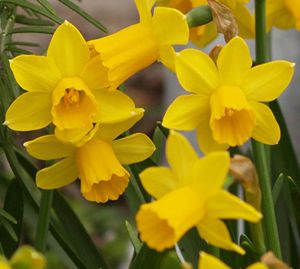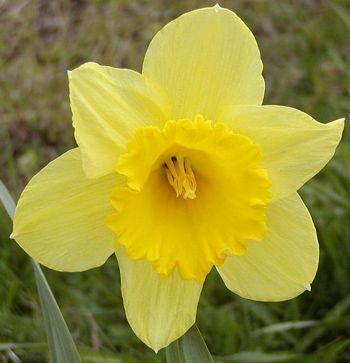How to Grow Daffodils Outside and Force Daffodil Bulbs Indoors
Are you curious about how to grow Daffodils outside, or force Daffodil bulbs indoors? If so, you’re in the right spot! What follows is our information about growing these pretty flowers.
 |
| Tete-a-Tete Daffodil |
Daffodils are among the first flowers to bloom in the spring. They bring the promise of warmer weather as well as a much needed burst of color to the still grey and dull landscape of your yard or flower beds. Like other bulbs, daffodils are very easy to grow.
Plant daffodils in the fall and plant them about 2 to 4 weeks before the ground freezes to allow the roots to develop underground. Plant them 6” – 8” deep and space them 3” to 6” apart. Daffodils will tolerate some crowding though. Add Dutch bulb food or bone meal while you’re planting to add that extra kick to help the bulbs. Daffodils are native to woodlands so they will grow well in conditions from shade to full sun. After they bloom in the spring, allow the plants to grow until they die off. They need time after blooming to store energy in the bulbs for the next year. To remove the dead plant either snip off at the base or just twist the leaves while pulling lightly. Dig up your bulbs every couple of years to separate and then replant them as they will multiply over time.
** Squirrels, chipmunks and other rodents do not like the taste of daffodil bulbs.**
Daffodils are also great as forcing bulbs to have blooms indoors. The best container used to force Daffodil bulbs is what is called an azalea pot. They are about ¾ tall, or else a bulb pan; however anything that would work for a house plant would work for forcing bulbs, as long as it drains well. The container you are using should be filled about ½ to ¾ of the way with potting mix and then moistened. Gently press the bulbs into the moist potting mix with the broad base down and the pointed end up. They should be arranged as close together as possible without touching each other or the container itself, to gain the best look. Barely cover the bulbs with additional potting mix and water gently, if the bulbs become exposed add some more soil as settling may occur once watered.
Now the container should be placed in a dark, cool area for 12 weeks or longer, depending on the bulb. The temp must remain below 48º F, but above freezing (35º - 40º is recommended). While total darkness is the best if they are placed in a refrigerator the light that comes on when they are opened is not an issue to worry about. Once the roots begin growing out of the drainage holes (depending on the size of container you’re using) or the shoots start to grow start to give the bulbs a gradual transition to warm. Be careful not to expose the bulbs to warm temps too fast, as this may cause the blooms to emerge too fast and they will end up failing before they have a chance to open. Start the out in the coolest spot in your house and gradually move them to warmer areas. Rotate the containers ¼ turn every few days to help with even growth and to keep the stems upright. Try to keep the soil moist, but not soggy.
Once the bulbs have finished flowering, remove the spent flowers but continue to water and provide light for the foliage. The bulbs can be planted outside when the weather permits just as with any perennial. Don’t remove the foliage until it has turned yellow.
 |
| Dutch Master Daffodil |
Forcing bulbs takes a lot out of them and they may not produce the same way the next season, but with time they will come back. Bulbs shouldn’t be forced more than once, so make sure to use new bulbs each fall for forcing.
